Tumasulo Algorithm
Dynamic Scheduling
💡 Idea: Get rid of stall cycles by allowing instructions to execute out-of-order
Road analogy:
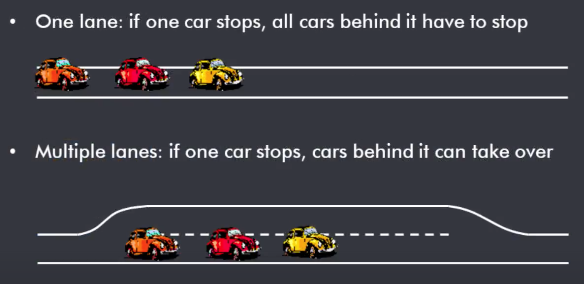
- An in-order-processer is like a road with one lane
- If one car stops, all car behind it have to stop
- An out-of-order-processor is like a road with temporarily multiple lanes
- If one car stops, the car behind it can take over
Tumasulo’s Algorithm
🎯 Goal: High Floating-Point (FP) performance without special compilers
Key Structures
Consider following instructions:
DIV.D F0, F2, F4
ADD.D F10, F0, F8
SUB.D F12, F8, F14
ADD.Ddepends onDIV.D(true dependency onF0, Read-After-Write)
- In-order execution:
DIV.D–>ADD.D–>SUB.D. There’ll be a lot of stall cycles due to data dependency- Out-of-order execution: We want
SUB.Dto proceed whenADD.Dis waiting forDIV.D
- To allow
SUB.Dto proceed, we need to bufferADD.Dsomewhere- In Tumasulo’s Algorithm these buffers called Reservation Stations (RSs)
- To allow
ADD.Dto proceed when its operands become available, RSs must be informed when result available- In Tumasulo’s Algorithm results are broadcasted to all RSs on Common Data Bus (CDB)
Tumasulo Pipeline Phases
- Pipeline phase: may takes several clock cycles
- Pipeline stage: always takes SINGLE clock cycles
IF: fetch next instruction into FIFO queue of pending instructions
Issue
- Get next instruction from head of instruction queue
- If there is a matching RS (i.e., no structural hazard), then issue instruction to RS
- Write operand values if they are currently in registers
- Otherwise, write identifiers of RSs that will produce operands
Execute
- When all operands available (i.e., no RAW hazard) and Functional Unit (FU) are free, then execute
- If not, monitor CDB for result to become available
Write result
- Write Result on CDB to all awaiting RSs and register file
- Mark RS free so that it can be used for another instructions
Tumasulo-based FP Unit
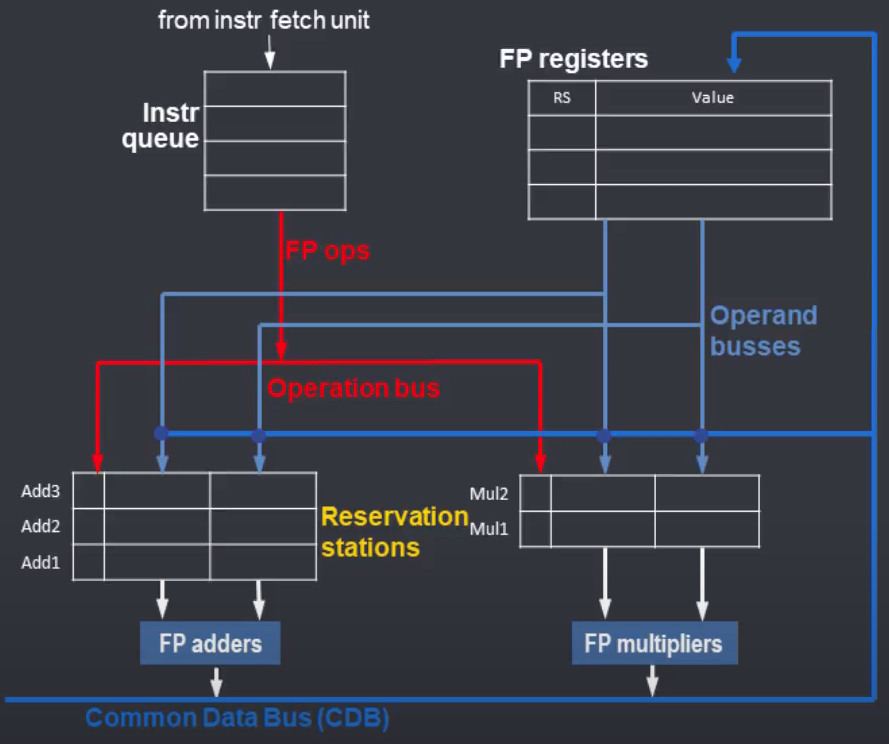
Reservation Station (RS) Structure
Each RS has 7 fields:
op: Operation to performRS1: RS that will produce 1st operand0: indicates that operand is available
RS2: RS that will produce 2nd operandval1: Value of 1st operandval2: Value of 2nd operandImm/addr: holds immediate or effective addressbusy:1: RS is occupied0: RS is free
Example
- Add
- 1st operand being produced by RS
Mul2 - 2nd operand available in register with value 12.55
Then the content of RS is
| op | RS1 | RS2 | Val1 | Val2 | Imm/addr | busy |
|---|---|---|---|---|---|---|
| add | Mul2 | 0 | n/a | 12.55 | n/a | 1 |
Register Structure
Each register also has field RS:
- RS ID that will produce this value
- Blank/0 if not applicable
Example
| Register | RS | Value |
|---|---|---|
| F0 | ||
| F1 | Mul1 | |
| F2 | ||
| F3 | Add2 |
- The
RSfield of F0 and F2 are blank, which means currently they contain valid value - F1 is currently being produced by RS
Mul1 - F3 is currently being produced by RS
Add2
Tomasulo’s Pipeline Phase Details
Issue
- If a matching RS is available -> Issue FP instruction
- If source operands
- currently available in the register -> It is issued together with the operand value
- currently “in-flight” being produced -> The instruction is linked with the RS that will produce this operand value
Example
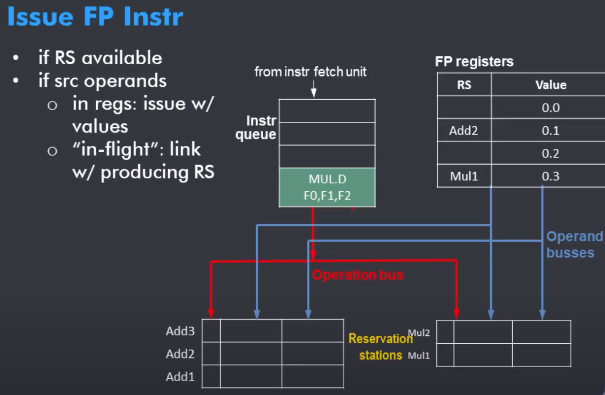
MUL.D F0, F1, F2 is at the head of the Instruction Queue
- Register
F2is available and contains the value 0.2 - Register
F1is being produced by RSAdd2
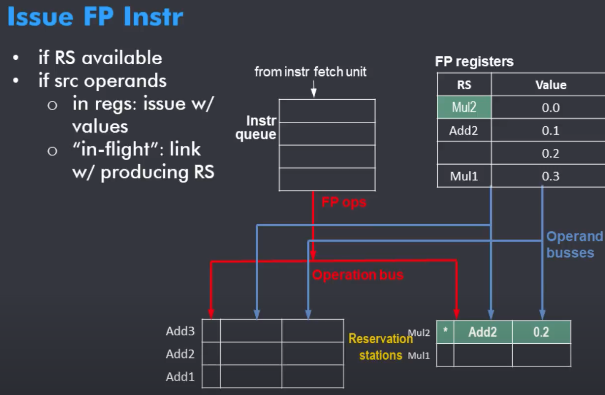
The multiply instruction will issue to RS Mul2
- The first operand will be produced by RS
Add2 - The second operand is already available and equals 0.2
As the multiply writes register F0, the RS field of register F0 has been set to Mul2 since this is the RS that will produce it.
Execute
- Execute when all operands are available (no RAW hazard)
- Several instructions may become ready at same time
- For FP RS, order of execution is arbitrary (usually FIFO)
- Load/Stores are executed in-order
Write Result
When Functional Unit (FU) has produced the result , write it on CDB and from there to any RS and register waiting on it
Example
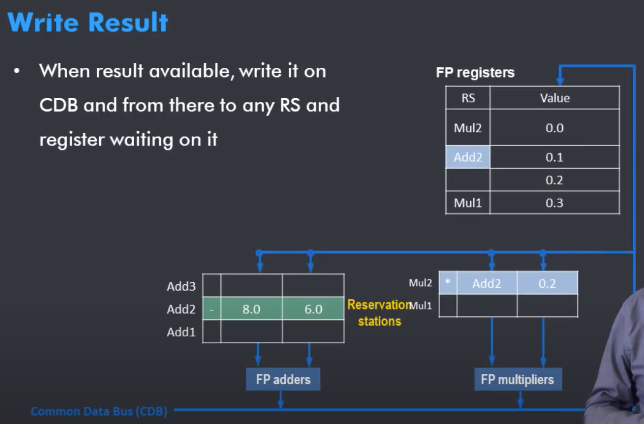
The RS
Add2is ready to executeRS
Mul2is waiting for this result.This result needs to be written to register
F1
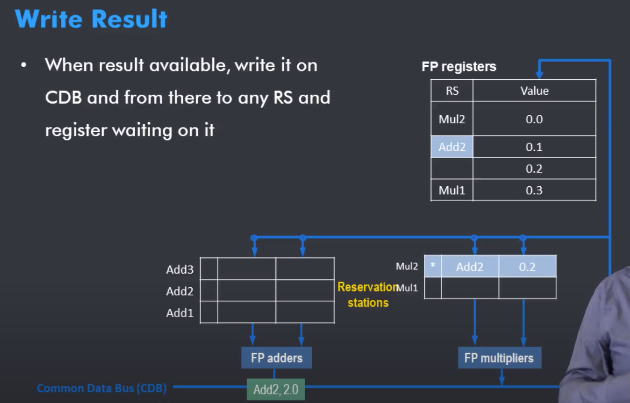
- The subtracted instruction in RS
Add2is executed. - It writes its result 2.0 onto the CDB together the identifier RS
Add2that has produced it
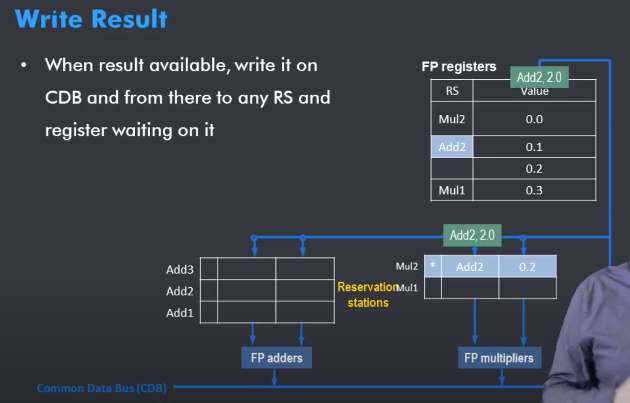
- The result is broadcasted on CDB to all the RS and registers
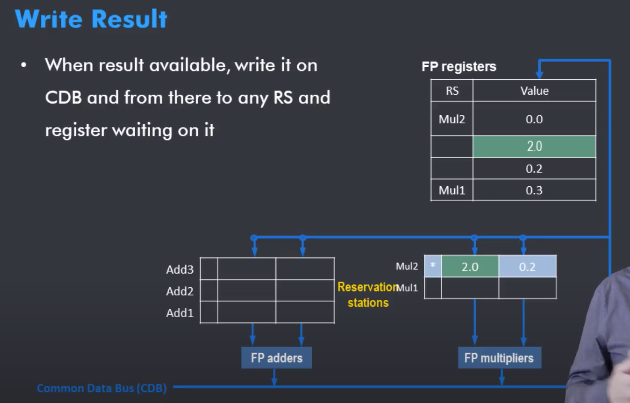
- The first operand of RS
Mul2is now available and equals 2.0 - Register
F1has been set to 2.0 and itsRSfield has been cleared
Features of Tomasulo
Register renaming (via RSs)
Elimination of name dependencies, i.e., WAR & WAW
(RS + Register File = virtual rgister set)
Distributed RS: allow operand forward to multiple RSs in 1 cycle
- For centralized Register File: sequential access if only 1 port 🤪
Bypassing / forwarding
A result is directly forwarded from execution unit to multiple RSs via CDB
In-order issue/dispatch
Out-of-order execution
Out-of-order instruction retiring/completion (No precise exception)
Tumasulo Example
Tomasulo with Memory Accesses
Dynamic Scheduling of Memory Access
Loads and stores to different address can be executed out-of-order
Loads and stores accessing same address cause hazards
Read-After-Write (RAW)
# R0 always has the value 0 S.D F5, 1000(R0) # store the value of register F5 in addr (R0+1000) L.D F0, 1000(R0)Write-After-Read (WAR)
L.D F0, 1000(R0) S.D F5, 1000(R0)Write-After-Write (WAW)
S.D F5, 1000(R0) S.D F5, 1000(R0)
Problem: Hazard is known ONLY AFTER effective address calculation 🤪
Example
S.D F5, 1000(R0) L.D F0, 1000(R1)If
R1=0, then hazard occurs. Otherwise not.Effective addresses of earlier memory accesses must have been computed!
Extend Tomasulo Algorithm with Memory Access (MA)
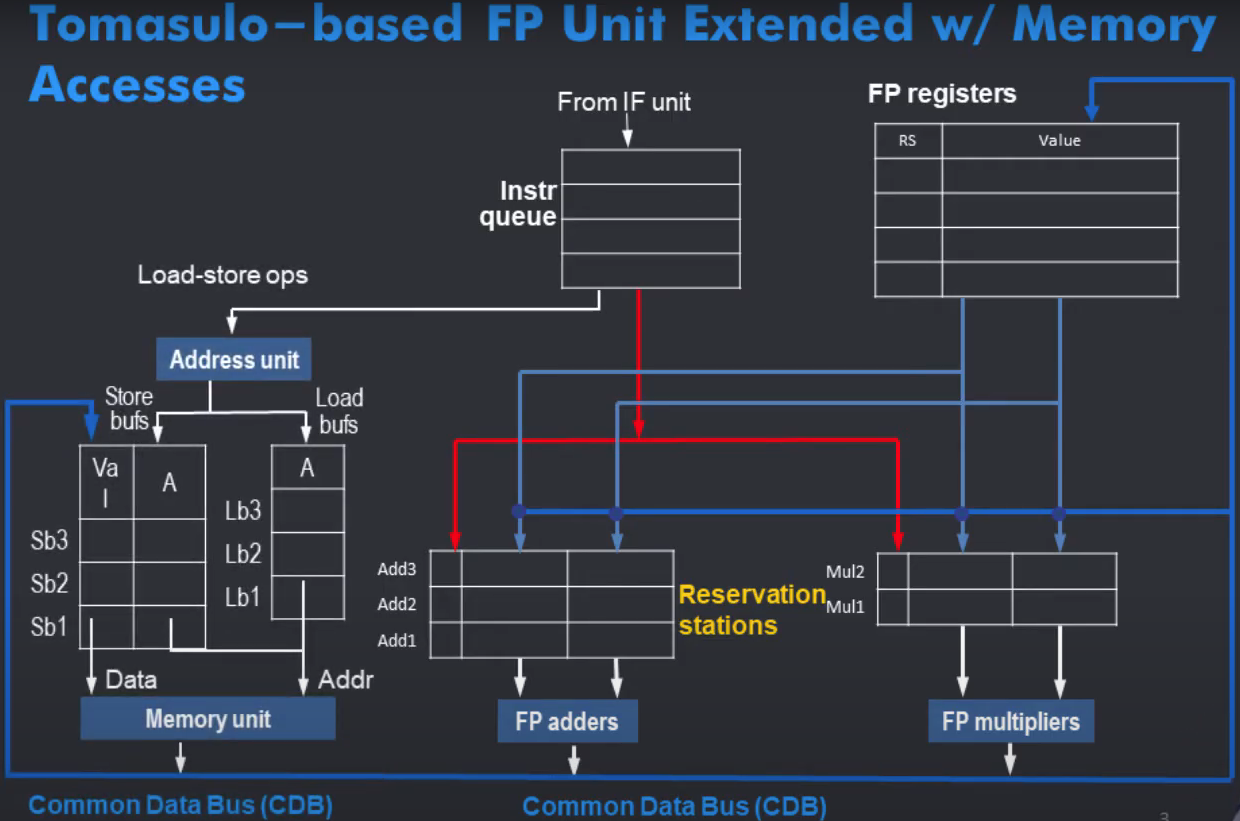
Memory hierarchy
- address unit
- load and store buffers
- memory unit
General process
- If
loadorstoreinstruction is retrieved from the head of the Instruction Queue, it is sent to the address unit - The address unit then
- calculates the effective address
- provided there is no hazard
- places the
loadorstorein one of the load or store buffers,- when the value loaded by a
loadis returned from memory, it will by placed on the CDB and from there to any waiting RS and register file
- when the value loaded by a
- If
Load and Store Execution
loadandstoreexecution consist of 2 steps:- effective address (EA) calculation
- memory access (MA)
Each
loadandstorebuffers has fieldAEA calculated in 1st step
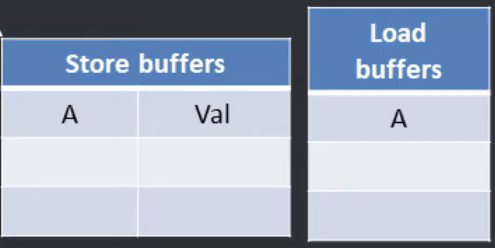
Store buffer has a
valfield which can also be RS producing this value- So a
storecan be placed in a store buffer before the value to be stored is available
- So a
RS can also be waiting for load buffer
E.g.:

The RS is waiting for load buffer 2.
Load and Store Issue
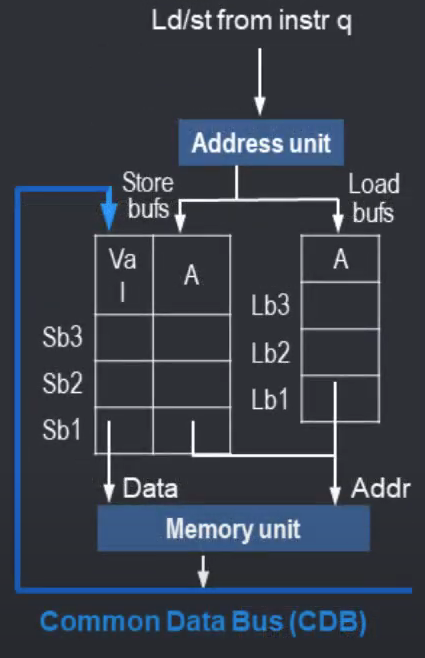
loadAddress unit calculates EA
EA is compared to
Afield of all active store buffersIf match -> RAW hazard
->
loadwon’t be sent to load buffer until conflicting store completes
store- Similar but must check for conflict in both load buffers (WAR) and store buffers (WAW)
Example
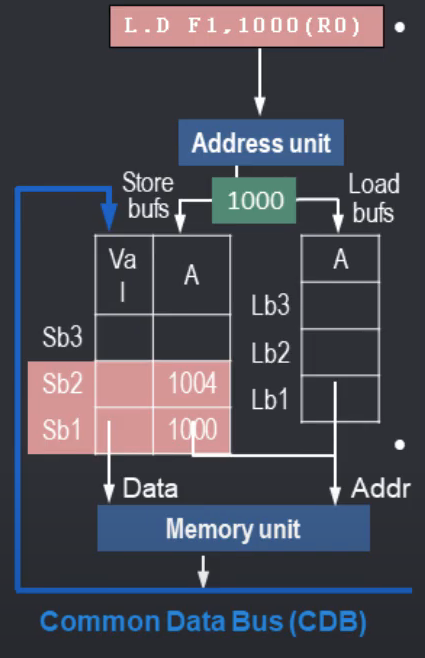
L.D F1, 1000(R0)is sent to the address unit- At this point in time, store buffer 1 is active and wants to write to address 1000
- store buffer 2 is active and wants to write to address 1004
- The address unit calculates the EA 1000
- Since store buffer 1 wants to write to the same address (1000) -> There is a conflict
- The
loadwill NOT be sent to one of the free load buffers until thestorein store buffer 1 completes
- The
load and store do NOT have to be sent in-order from the load and store buffers to the memory unit but can be freely reordered